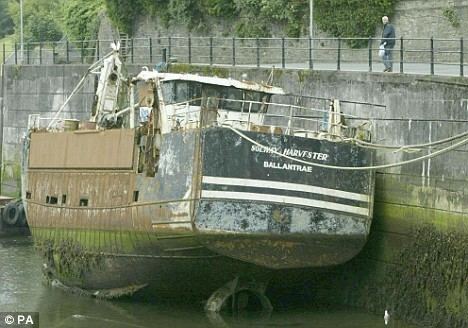Name Solway Harvester Class and type Scallop dredger Launched 1992 | In service 1992–2000 Crew 7 Length 21 m | |
 | ||
Fate Sunk on 11 January 2000 Status Salvaged, laid up in the harbour in Douglas, Isle of Man, and finally scrapped. | ||
Solway harvester
The Solway Harvester was a scallop dredger from Kirkcudbright, Scotland which sank off the coast of Ramsey, Isle of Man in heavy storms on 11 January 2000 with the loss of all seven crew members.
Contents

Following salvage, the damaged ship was taken to Douglas, Isle of Man, where she remained until cut up for scrapping in January 2014.

Career and sinking

The Solway Harvester was launched in 1992. An automated scallop dredger, she was fitted with sections along the sides which would rotate out and upwards to deposit the catch on the deck. She was 70 ft (21m) long and had accommodation for eight on board, plus a workshop, ice machine and storage for the catch. She was owned by Richard Gidney and operated under the command of her skipper, Andrew (Craig) Mills. Her crew were all from the Isle of Whithorn area of Dumfries and Galloway.

On her final voyage, the Solway Harvester sailed from Kirkcudbright in the early hours of 10 January 2000. She headed into the Irish Sea to harvest scallops from the queen scallop grounds. There were seven crew members aboard, two were as young as 17. They remained off the grounds until the afternoon of the following day, 11 January. Having collected 150 bags of scallops, they hauled in their gear and began the return voyage. The weather meanwhile had begun to worsen, and skipper Craig Mills decided to seek shelter in Ramsey Bay, Isle of Man. Mills made a final phone call at 17:29.
Nothing further was heard until 17:47, when a satellite picked up an emergency position radio beacon. A search and rescue mission was quickly organised, with lifeboats from Workington, Douglas and Ramsey and Port St Mary being launched. Helicopters flew out from RAF Prestwick and RAF Valley and a helicopter from the Irish Air Corps and a fixed wing aircraft from the Royal Ulster Constabulary joined in the search. Larger vessels also joined the search, with RFA Bayleaf and the Ben-my-Chree, the Isle of Man ferry moving into the area to help. The search was called off at dusk on 12 January, when two unopened liferafts were found. The Royal Navy was called in to assist and the Sandown class minehunter HMS Sandown began to search the sea bed. Sandown eventually located the wreck of the Solway Harvester on 15 January lying in 115 feet (35 m) of water, 11 miles (18 km) off the Isle of Man. The bodies of all seven of the crew were found on board. They were: Andrew (Craig) Mills, Martin Milligan, Wesley Jolly, David Lyon, Robin Mills, David Mills and John Doyle Murphy.
Cause of sinking
The Marine Accident Investigation Branch launched an inquiry to determine the cause of sinking. In a report published in 2003, they concluded that the Solway Harvester’s fish room had flooded, making her unstable and eventually causing her to capsize. The report found that there were critical maintenance issues, including a flood alarm that did not work and a missing hatch cover. Water had drained unnoticed into the fish room through the deck scuttles, which had not been covered. The pump was blocked and the broken bilge alarm meant that the flooding went unnoticed by the crew.
As the weather worsened to a Force 9 Gale, the Solway Harvester began to roll. Already unstable, she was eventually rolling at an angle of between 30 and 40 degrees. More water entered through the open deck scuttles, whilst the cargo shifted to starboard. Water became trapped on the main deck and continued to flood the fish room. The design of the Solway Harvester should have allowed her to return to rolling at 20 to 25 degrees, but the flooding had caused her to lose this stability. She continued to roll further and further on to her side, eventually capsizing suddenly.
The Solway Harvester was salvaged and raised in a £1 million operation funded by the government of the Isle of Man. Relatives of the victims later accused the Scottish Parliament of not doing enough to support the salvage operation. Richard Gidney was put on trial for manslaughter following the report, but the case collapsed in 2005.
The boat sat in the harbour in Douglas, Isle of Man, available as evidence during the inquest into the fatalities. A memorial was erected on Douglas Head on the Isle of Man, in memory of those lost. Solway Harvester.
On 8 November 2008, Coroner Michael Moyle ruled the deaths of all seven crew members as accidental. Parts of his report were heavily critical of Solway Harvester owner Richard Gidney over the ship's standard of maintenance and equipment, as well as her past safety record.
The Solway Harvester was scrapped in a process that began in November 2013.
Media interest
In addition to news items, the Solway Harvester has featured in the BBC documentary series Coast (series 5, episode 1, first broadcast in the UK on 25 July 2010). The role of Reverend Alex Currie, who became the spokesperson for the bereaved families, was featured in a BBC Radio 4 documentary "A Life Less Ordinary", first broadcast on 13 October 2012.
